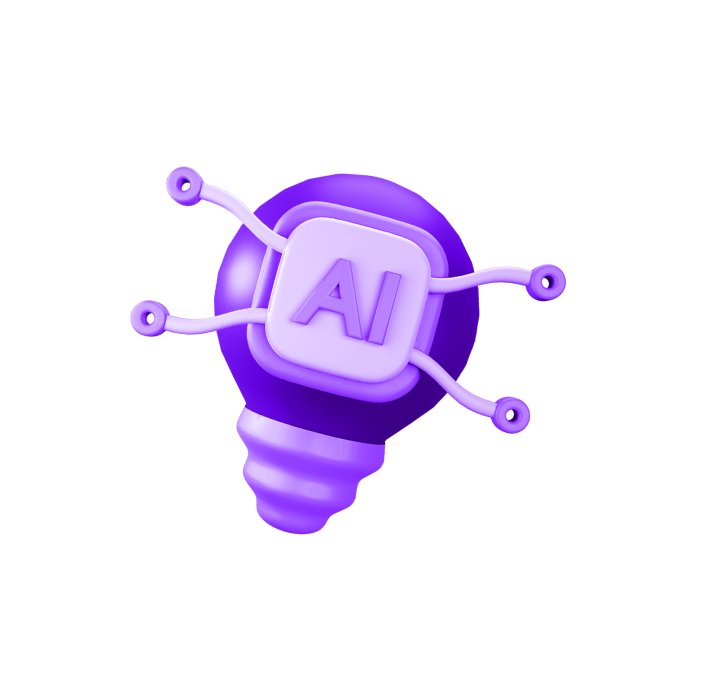How incorporating AI into company workflows can streamline processes
Let’s explore the advantages of employing AI in your business workflows and how to use business intelligence with AI to gain cognitive insights.
1 May, 2023During the last few years, we have witnessed technology evolve at a staggering pace, and the need to adapt to stay competitive is now felt even more strongly among all modern companies and startups. Modernization is all around us, from scaling engineering teams to building AI assistants.
One of the latest advancements that companies can leverage is artificial intelligence. For example, artificial intelligence in fintech has proven to be a game changer recently. But it’s not just the financial industry…
Let’s explore the advantages of employing AI in your business workflows and how to use business intelligence with AI to gain cognitive insights. We also delve into the challenges of AI integration and how to overcome them, so by the end of this article, you will have the tools to embrace AI as the cornerstone of your future business workflows.
Understanding artificial intelligence in business processes
Incorporating AI into any company’s workflows can streamline processes, improve efficiency, and reduce costs. However, offering development services, our frontend web development company knows full well that implementing AI effectively requires a deep understanding of the technology.
Since AI can allow machines to perform tasks that typically require human intelligence, such as decision-making, language processing, and pattern recognition, it can be integrated into business processes and workflows to automate repetitive tasks, analyze data, and provide predictive insights.
Understanding AI in business processes requires a more comprehensive dive into the technology and its capabilities and limitations. Identifying your specific business processes that can benefit from AI integration is essential, and only then can you unlock its potential.

Challenges of AI integration in business workflows
Despite the numerous benefits of AI integration in business workflows, it has its challenges. One of the primary ones is data quality, as AI models require vast amounts of high-quality data to deliver accurate results. Since AI models rely heavily on large, diverse, and high-quality data sets for training, poor data quality can negatively impact the accuracy and effectiveness of your AI integration.
Data privacy and security are also significant concerns, as AI systems can potentially expose sensitive information. Same with transparency and bias. One of the most important things is to make sure your AI solutions do not discriminate against certain groups or violate privacy regulations.
The high cost of AI development and implementation can also be a barrier for small and medium-sized businesses, especially if the business faces a shortage of AI experts with the knowledge and skills to effectively develop and deploy AI solutions.
This leads us to another challenge, which is the need for a skilled workforce to develop and manage AI systems. The lack of understanding of AI and its limitations among decision-makers can also significantly hinder AI adoption.
Another issue is ROI and cost. Implementing AI solutions can be expensive, and companies may struggle to justify the cost if the ROI is not immediately apparent. However, this is where AI API may come in handy.
Since integrating AI into existing business processes can be complex and time-consuming, requiring significant resources and expertise, one of the challenges you may face here as well is integration with legacy systems, particularly if the older systems were not designed with AI in mind.
All in all, all these challenges may be overwhelming but the result will most likely outweigh them by a mile. Remember all the advantages we discussed previously? But first, you need to know why integrate AI in the first place.
Advantages of employing AI in business workflows
Artificial intelligence can transform various aspects of business processes, from customer service to supply chain management.
With the ability to analyze vast amounts of data quickly and accurately, AI can provide insights that can help businesses optimize processes, identify areas of opportunity, and make data-driven decisions that can improve operational efficiency and reduce costs.
AI can also automate repetitive tasks, freeing up employees to focus on more complex tasks that require human intervention. AI-powered chatbots and virtual assistants can also enhance customer service by providing personalized assistance to customers around the clock.
Here are some more advantages of employing AI in business workflows:
- Improved scalability without needing to increase headcount, reducing the need for additional resources;
- Enhanced accuracy in analyzing data, leading to more accurate results and insights;
- Better risk management, allowing businesses to mitigate them before they cause any harm;
- Increased innovation that leads to more innovative products and services;
- Enhanced security - AI-powered security systems can detect and respond to threats faster and more accurately than traditional security measures;
- Personalized marketing, leading to higher conversion rates.

Illustrative use cases of AI
Let’s look at various real-world use cases of AI in business processes that illustrate its potential to transform how companies operate.
Streamlining operations through process automation
One use case of AI in business processes is streamlining operations through process automation. Here, AI is used to automate repetitive and time-consuming tasks such as data entry, processing, and analysis, freeing up employees to focus on higher-value activities.
In the banking industry, for example, AI-powered chatbots can be used to automate customer service, responding to inquiries, and resolving issues in real time. In supply chain management, AI can optimize inventory management, predicting demand and scheduling deliveries to reduce stockouts and excess inventory.

Pinpointing areas of opportunity with AI
This use case involves using data analysis and machine learning algorithms to identify areas where AI can be applied to improve business processes. Companies can identify patterns and insights that inform decision-making by analyzing data from various sources, such as customer interactions, sales, and marketing campaigns.
For example, in the retail industry, AI can analyze customer purchasing behavior and provide personalized recommendations to customers based on their past purchases. In healthcare, it has the means to analyze patient data to identify potential health risks and recommend preventative measures.
Using business intelligence with AI
Business intelligence requires collecting and analyzing data to gain insights into business operations, such as sales, marketing, and customer interactions. AI can enhance this process by automating data analysis and providing more accurate and actionable insights.
In the finance industry, AI can analyze market data, financial statements, and other relevant data sources to identify investment opportunities and risks. In manufacturing, AI is used to analyze data from sensors on production equipment to identify inefficiencies and optimize production processes.
Gaining cognitive insights
Gaining cognitive insights refers to the use of AI algorithms to analyze data and generate insights that go beyond simple data analysis. Unlike traditional data analysis, cognitive insights involve understanding the context and meaning behind data to gain a deeper understanding of business operations.
In healthcare, by combining data from various sources, such as medical records, lab results, and patient history, AI algorithms can generate insights that help doctors make more accurate diagnoses and develop more effective treatment plans.
Also, by understanding the cognitive factors that influence purchasing decisions in marketing, companies can create more targeted marketing campaigns and improve customer engagement.
Determining the issues AI can address effectively
Determining the issues AI can address effectively requires a systematic approach to identifying business problems that can benefit from AI-powered solutions. Here are the steps involved in the process:
- Start by identifying the business problem or pain point that needs to be addressed by analyzing data, observing business processes, and gathering feedback from employees and customers.
- Define the problem statement by clearly articulating the issue, its scope, and the desired outcome.
- Evaluate the availability and quality of data required to train an AI model to address the problem. This involves examining the data sources, data formats, and data quality.
- Assess the feasibility of AI-powered solutions for the identified problem.
- Evaluate the potential impact of an AI-powered solution on the business - assess the cost savings, efficiency gains, and impact on employees and customers.
- Develop a pilot project to test the AI-powered solution in a controlled environment (more on this later on).
Overcoming the obstacles of AI implementation
Overcoming the obstacles of AI implementation involves addressing the challenges associated with integrating AI into existing business processes.
One of the main obstacles is the lack of expertise and technical skills required to develop and deploy AI solutions. To overcome this, invest in training and hiring professionals with expertise in AI development and implementation.
Another obstacle is the need for large amounts of high-quality data to train AI models effectively. Fixing this involves improving data collection processes and investing in data quality and management tools.
Ethical considerations around AI implementation, such as privacy and bias, should also be addressed. For that, establishing ethical guidelines for AI development and deployment is key, ensuring that AI solutions are developed and used in an ethical and responsible manner.
Engaging industry experts
Engaging industry experts is a sure method of overcoming the obstacles of AI implementation by leveraging the expertise and knowledge of professionals with experience in developing and deploying AI solutions. Industry experts can provide valuable insights and advice on overcoming technical and operational challenges associated with AI implementation.
For example, companies can engage AI consultants and experts to assess their existing infrastructure and identify opportunities for AI implementation. These experts can help develop AI strategies that align with the company's goals and provide guidance on deploying AI solutions effectively.
Companies can also collaborate with academic institutions and research organizations to access the latest advancements in AI and gain insights into emerging trends and technologies.

Launching a pilot initiative
Launching a pilot initiative is another excellent method of overcoming the obstacles of AI implementation. All you need to do is test and validate your AI solutions before deploying them on a larger scale.
Pilot initiatives allow companies to evaluate the effectiveness and feasibility of AI solutions in a controlled environment and identify any technical or operational issues that need to be addressed.
A pilot initiative typically involves selecting a specific use case or business process to test the AI solution and collecting data on its performance. This data can then be used to refine and improve the AI solution before it is widely deployed.
Did you know that pilot initiatives can also help build internal expertise in AI development and deployment? They do that by providing hands-on experience for employees involved in the initiative, which can facilitate the broader adoption of AI in the organization.
Embracing AI as the cornerstone of future business workflows
In conclusion, embracing AI as the cornerstone of future business workflows can bring significant benefits to organizations, including increased efficiency, improved accuracy, and better decision-making.
While there are challenges and obstacles to implementing AI, companies have the potential to overcome them simply by engaging industry experts, launching pilot initiatives, and adopting other best practices in AI development and deployment we mentioned today.
Merge fully believes that, as AI will continue to advance and become more accessible, it is essential for our partners and other organizations to consider incorporating AI into their workflows to stay competitive in the marketplace.

